
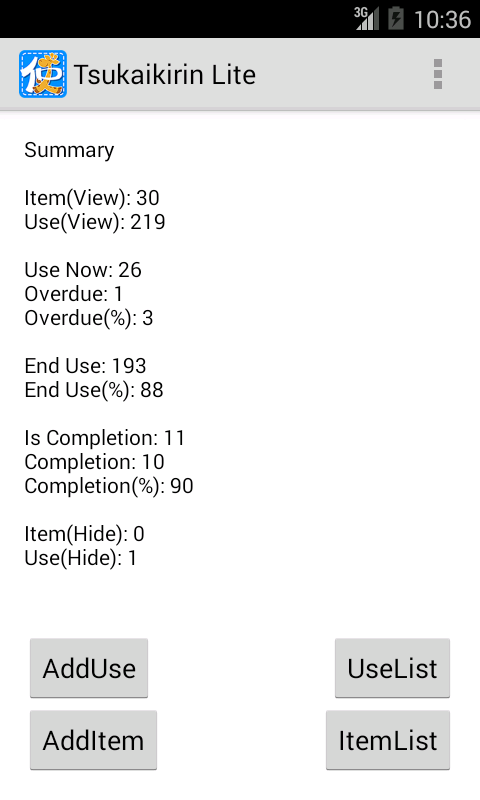
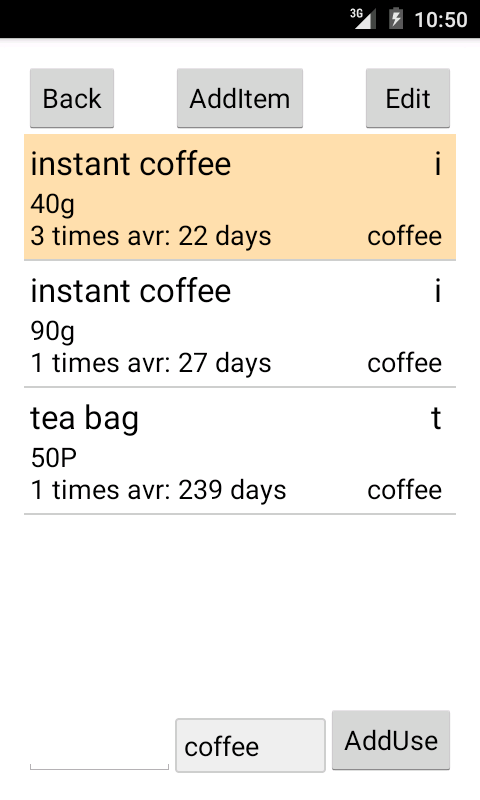
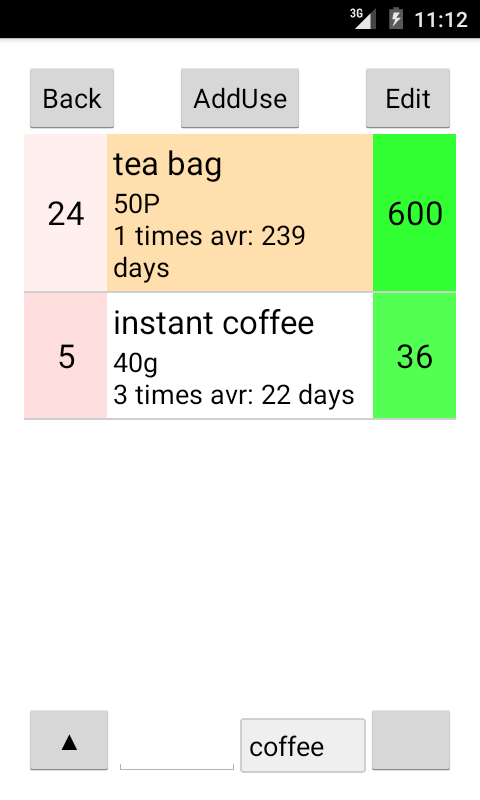
Situations such as function additional for Android you can see here (External site : Japanese Only).
It called the "use up" in the Japanese "使いきり(Tsukai-kiri)".
It called the giraffe in Japanese "きりん(Kirin)".
"Tsukai-kiri + Kirin = Tsukaikirin" is a pun of Japan.
This is the app to help you be used up and Best Before.
Easily viewable , Easy to operate , Fast and Easy to understand.
Also you can manage the best before date in the food.
Inventory and the remaining amount , regardless, it will manage only whether in use.
Since reference automatically past usage record, you can see around the next buy.
Ad display no . User registration is not required.
You can write the data for export. Please try anyway.
for Android 2016.05.21
version 1.0.4 on store Change log
for iPhone 2015.06.16 undecided




※ Image is a thing of the Android version in development.
Lite is free.
Equipped with necessary and sufficient function.
However, by the convenience of the differentiation of the Pro, it has the following limitations.
The upper limit of the number of items that can be registered is 30.
The upper limit of the number of items also includes items that are hidden. It does not include the number of the deleted item.
Bug fixes can be done, but additional functions will performed on Pro as a general rule.
If the feature gap between Pro was too open, it is expected to reflect some of the features the difference in Lite.
Lite and Pro will maintain data compatibility in principle.
Regardless of the Lite and Pro, individual support will be paid Please note.
for Android 2016.05.21
version 1.1.4 on store Change log
for iPhone 2015.06.16 undecided

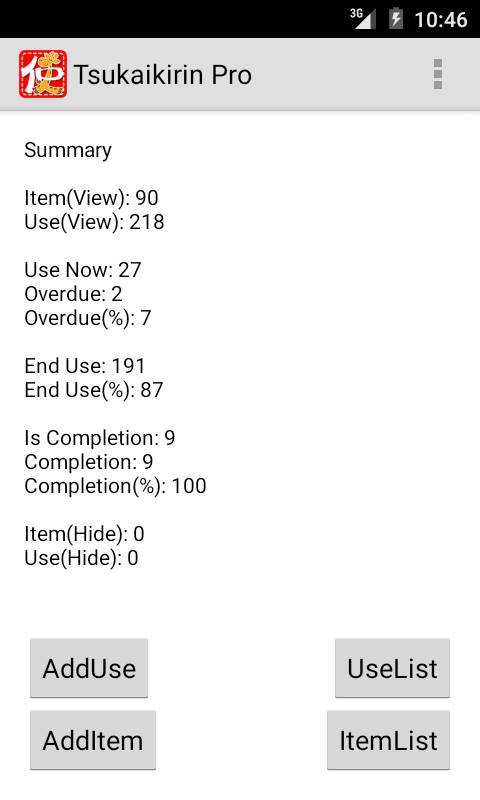
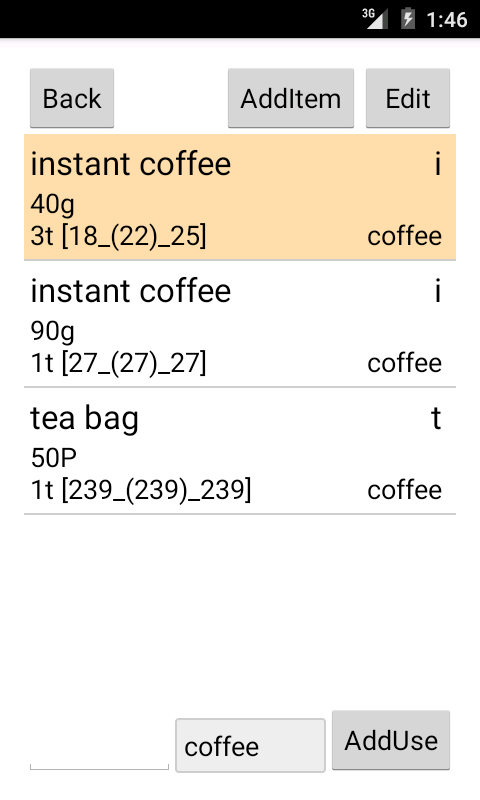

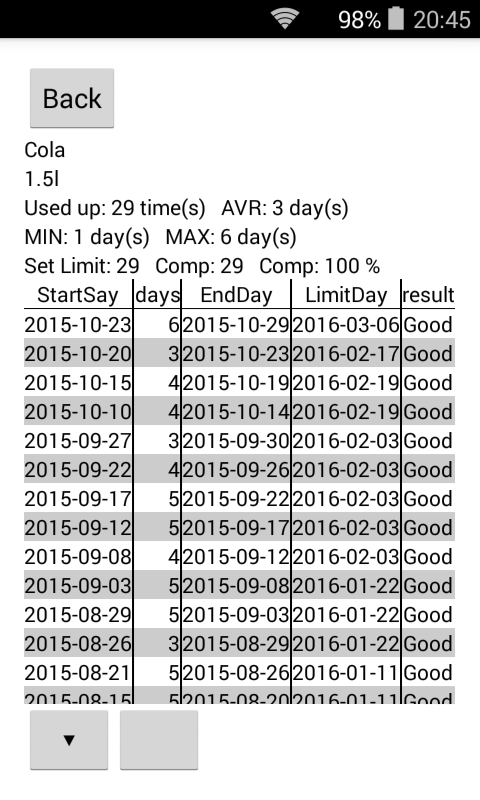
※ Image is a thing of the Android version in development.
In "ItemList" screen and the "UseList" screen, when you double tap is the line, a transition is made to "Use Listory List" screen for that item.
It was to display the "shortest" and "longest" not only the "average" to "UseList"screen and "ItemList"screen.
Display method is "times [shortest_(average)_longest]".
We have to open the "AddItem" screen from the "UseList" screen and "UseAdd(Edit)" screen.
We have to be able to "Done & AddUse" in "AddUse(Edit)"screen.
There is no limit on the Lite.
Reflect and new features additional demands, including the demand for Lite, you performed on Pro.
Lite and Pro will maintain data compatibility in principle.
Regardless of the Lite and Pro, individual support will be paid Please note.
Use the beginning, you should not greedily the object to be managed by this app.
Anything and everything you get tired soon as input becomes very to be put.
The first is the opening time-consuming seasoning to use up from (example:mayonnaise) is recommended.
When used up several times, it will become fun and come alive data.
There is a concept of the "Item", "Use".
"Item", please think it's product name, such as "mayonnaise".
"Use", it is recorded that with forever "Item" from time.
One for the "Item", any number of times "Use" occurs.
It is feeling that "I bought because mayonnaise is used up!" In the "Use" increases.
There is no essential field , but about "Title" is better that it had been put would be safe.
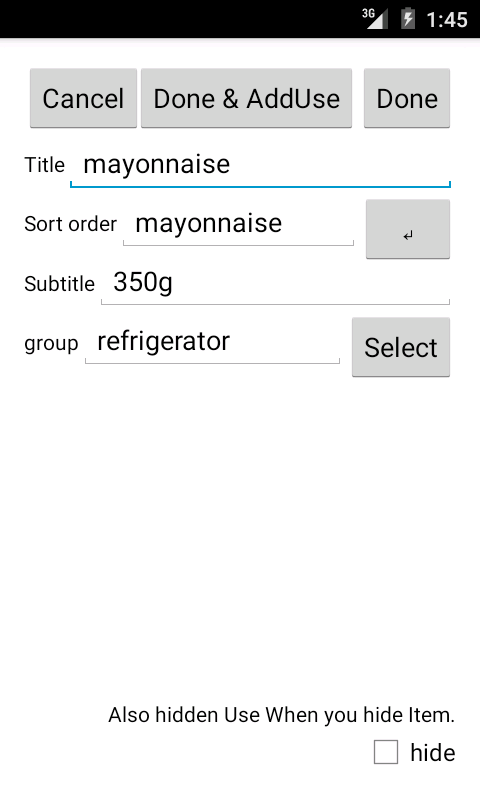
※ Image is a thing of the Android version in development.


※ Image is a thing of the Android version in development.
※ Left is Lite, Right is Pro.
You can narrow in the list screen put the "group".
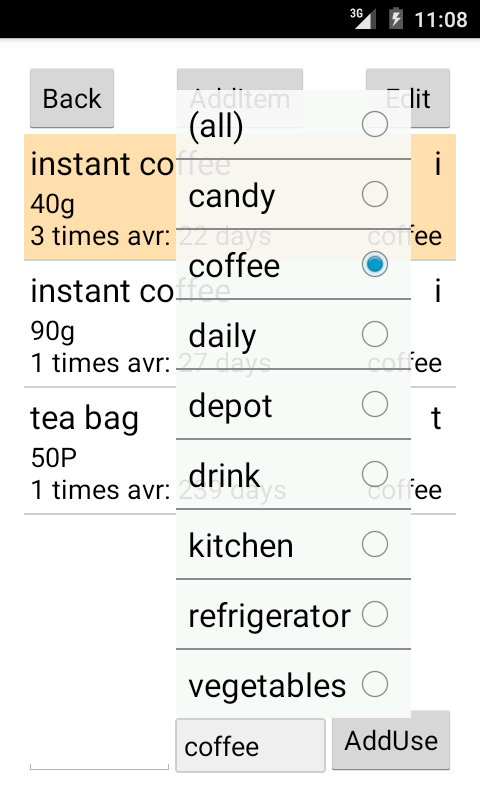
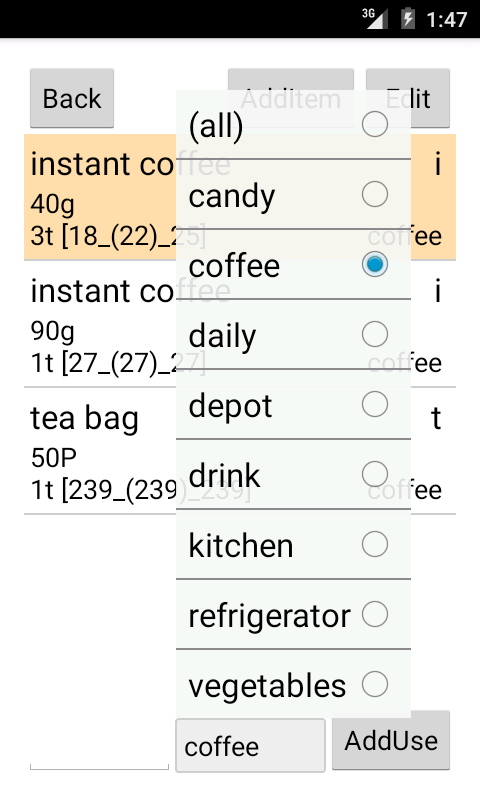
※ Image is a thing of the Android version in development.
※ Left is Lite, Right is Pro.
"Item" in the selection formula , it is mandatory.
"LimitDay" is not required. In the case of food, you may want to set the best before date.
Once used up , let's put the "EndDay".
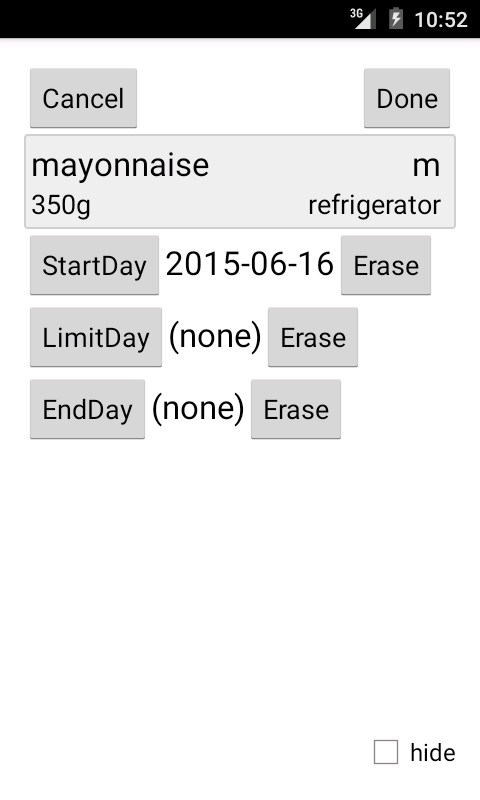
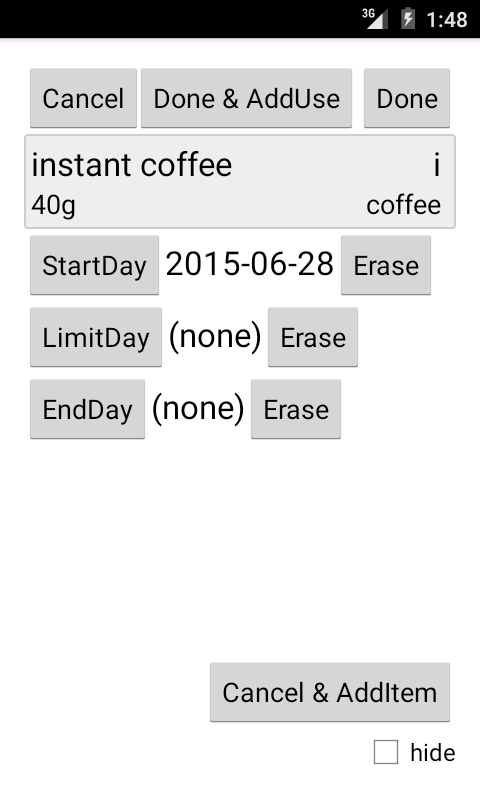
※ Image is a thing of the Android version in development.
※ Left is Lite, Right is Pro.
It is fun.


※ Image is a thing of the Android version in development.
※ Left is Lite, Right is Pro.
Number column on the left , is the number of days from the "StartDay".
If you have not yet used up even once, you can have a light blue.
As it approaches the past of the average single-use days, the color will become darker.
Number column on the right , is the number of days until the "LimiteDay".
Divide the period from the "StartDay" to "LimitDay" to 10 stage , the color will change.
When it is used up, it is possible to share the excitement.
Of course, it does not matter at all without having to share.


※ Image is a thing of the Android version in development.
※ Left is Lite, Right is Pro.
If the you hide an item , also hidden use.
Even if you hide the use , not hidden items.
Even if you have something to hide , it is possible to be displayed again.
Export data , Import data , deletion of hidden data , You can.
When you deletion of hidden data , it will be completely erased.
Export and Import , it can be done on the screen Copy & Paste or SD card .
Data move from Lite to Pro recommend Copy & Paste.
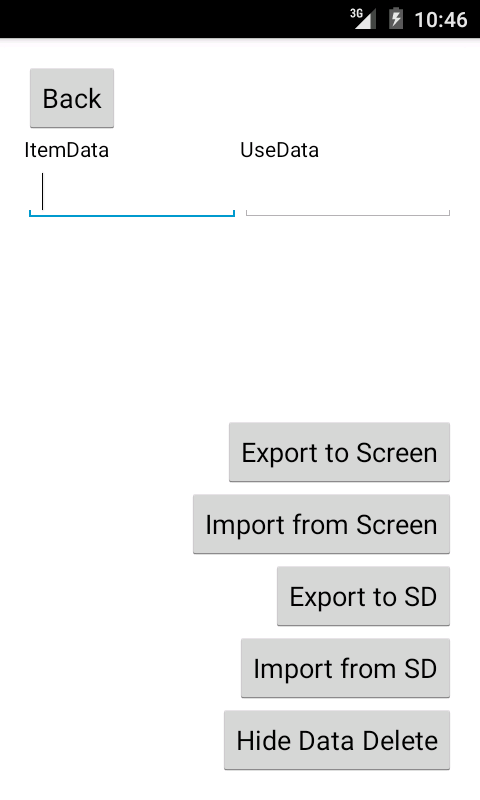
※ Image is a thing of the Android version in development.
Lite Data File path
(SD card directory)/Android/data/com.noppoland.android.tsukaikirinlite/
Pro Data File path
(SD card directory)/Android/data/com.noppoland.android.tsukaikirinpro/
File name of Item:item.txt
File name of Use:use.txt
Character code:UTF-8
When you export , you overwrite even if there is a file with the same name.
(Separated by a line break, The number of items repeatedly)
Database Version (integer, The first line only)
ID of Item (integer, primary key, not null, increment)
Title(text)
Sort order(text)
Subtitle(text)
group(text)
Flag of hide (integer, not null, 0:view, 1:hide)
(Separated by a line break, The number of items repeatedly)
Database Version (integer, The first line only)
ID of Use (integer, primary key, not null, increment)
ID of Item (integer,not null)
StartDay(text,YYYY-MM-DD)
LimitDay(text,YYYY-MM-DD)
EndDay(text,YYYY-MM-DD)
Flag of hide (integer, not null, 0:view, 1:hide)
Import is handled on an aggregated basis for each data.
If an error occurs during the import , you do not write all of the data in the Database.